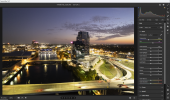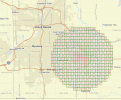I just use a single Firehouse Arc V on top of my drone for manned aircrafts to see. I did however order two more of those bottom facing Arc V in 'multicolor' that I will set up for red and green flashing, and that's purely for my own orientation viewing.
Also as Vic Moss said (and course reminded me in a facebook group), the strobe isn't required for rec fliers, but if you're going to get some might as well get ones that can be able to be used under Part 107.
Far as impact on photo/video being on top. You have to be pretty close to subjects to see it, or filming something rather reflective/mirrored (like a skyscraper kind of building with all glass).
At distances like this, it would be hard to see it noticeably reflected in anything.
If you're flying thru a canopy of trees or getting really close to a rock face with a little upward tilt, then you may see the flash there.











